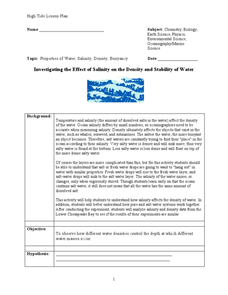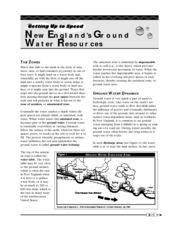Curated OER
Jeopardy
Providing an interactive experience, this Jeopardy-style game leads players through a review of scientific concepts. The presentation covers topics such as sound, the Earth's layers, magnetism, and the states of matter. This would be a...
Colorado State University
How Far Away Is Space?
Outer space may be a lot closer than you think! Science scholars model the layers of the atmosphere using transparencies to gain insight into the scale of space. The resource includes ideas to tailor the activity to the skill level of...
Museum of Science
Worm Farm
It is not a barrel of monkeys—it's a jar of worms! Scholars create a worm farm in a spaghetti sauce jar. Pupils layer moist soil, sand, and oatmeal to create a habitat for worms. Individuals place worms into the habitat, cover it with...
NOAA
Subduction Zones
Sink into an interactive learning experience about subduction zones! Junior oceanographers examine the earth-shaking and earth-making effects of subduction in the fourth installment in a 13-part series. Hands-on activities include...
STEM for Teachers
Tsunami!
How does the depth of an ocean affect the speed of a tsunami's waves? Use Jell-o, graham crackers, and marshmallows to model the effects of an underwater earthquake and its resulting tsunami. The instructional activity includes hands-on...
Curated OER
Layers of the Earth
In this Earth worksheet, students find 8 words, related to the Earth, in a puzzle. Students also use the words to answer 8 questions about the layers of the Earth.
Curated OER
Earth's Layers Online Activity
In this Earth's layers worksheet, students click on the links in the questions about Earth's layers to find the answers to the questions and then come back and answer the questions. Students answer 12 questions total.
Curated OER
Explosive Ideas: Oregon quarter reverse
Explore Earth and her amazing layers with this lesson on planetary change. Students will research the ways in which Earth's layers cause change. They will complete a "Tectonic Puzzle" and use a worksheet to answer questions about Earth's...
Curated OER
Rocks Worksheet #3
Here is a worksheet in which junior geologists determine where the igneous, metamorphic, and sedimentary rocks might be found on a diagram of rock layers in Earth.s crust. They show what they know through a series of five multiple choice...
Curated OER
Layers of The Earth
In this earth science worksheet, students label the graphic organizer of the earth for the parts of the rock layers of the planet that include the crust, mantle, and core.
Curated OER
The Rock and Fossil Record-Science Puzzlers, Twisters & Teasers
In this earth science worksheet, students complete 12 questions about rocks and fossils in the form of anagrams, riddles, sequences, and brain teasers.
Curated OER
The Atmosphere
Here is a suitable set of slides to use when teaching about the layers of the atmosphere, climate, global winds, and types of clouds. These slides will support a few different lectures. You will probably want to replace the diagrams with...
Curated OER
Women in Science: Dr. Grace Bush
Learn about the study of paleoecology with a resource about Dr. Grace Bush and her contributions to the field. After reading a one-page passage, learners answer comprehension questions and explore their personal interests in different...
Curated OER
Earth's Layers
Students identify the interior layers of the Earth and analyze a diagram. In this Earth's layers instructional activity students create a model of the Earth's interior.
Curated OER
The Magma Also Rises
Convection is thoroughly demonstrated using a model of Earth's mantle. Detailed background information is provided for the teacher, as well as a list of materials. Although a colorful and detailed worksheet is available for the class,...
Curated OER
Layers Of The Earth
Learners examine the layers of the earth and the basic composition and thickness of each. Using construction paper, each student models the layers of the earth.
DiscoverE
Core Sampling
Simulate soil sample assemblages. Individuals create soil layers in a cup. They then use straws to collect core samples from these layers. What information can they glean from the core samples, I wonder?
Curated OER
Investigating the Effect of Salinity on the Density and Stability of Water
Water with varying amounts of dissolved salt are dyed and then used to compare densities. The objective is to discover the effect of salinity, and therefore density, on ocean water on the stability of the ocean. Many branches of science...
Curated OER
Volcanoes: Sixth Grade Lesson Plans and Activities
Bring a set of pre-lab, lab, and post-lab lesson plans on volcanoes to your earth science unit. Sixth graders explore the three types of volcanoes found on Earth, plot the specific locations of these volcanoes on a map, and...
Environmental Protection Agency (EPA)
New England's Ground Water Resources
Learn all about where ground water is stored, how it moves, and how it is accessed in a detailed and thorough 10-page reading. Whether supplementing reading for an existing environmental or earth science course or providing background...
Curated OER
Do We Need to Wear a Rainhat? Acid Rain: Causes, Effects, and Possible Solutions
Acid rain, and how it affects the environment, is the focus of this Earth science lesson. During the study, learners evaluate measures to reduce acid rain, and design an investigation to demonstrate the conection between a hypothesis and...
Curated OER
Layers of the Earth: Plate Tectonics
Sixth graders participate in a instructional activity that is about investigating the different layers of the earth and defining how the plates move over the mantle. They engage in a variety of activities and use mathematics to create...
Curated OER
Label the Earth Diagram
In this earth's layer worksheet, students label a diagram of the earth's layers. They are given 4 terms and their definitions to read and students determine which layer is which on the diagram based on the definitions.
Curated OER
Earth's Structure
In this earth worksheet, students complete a graphic organizer by filling in the 4 layers of the Earth and a brief description of each layer.























